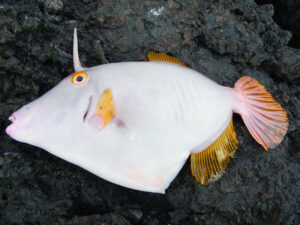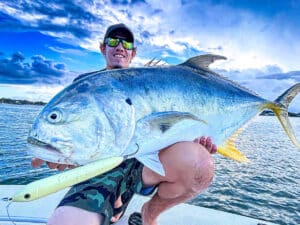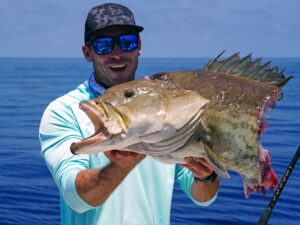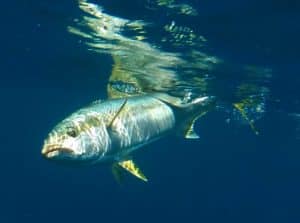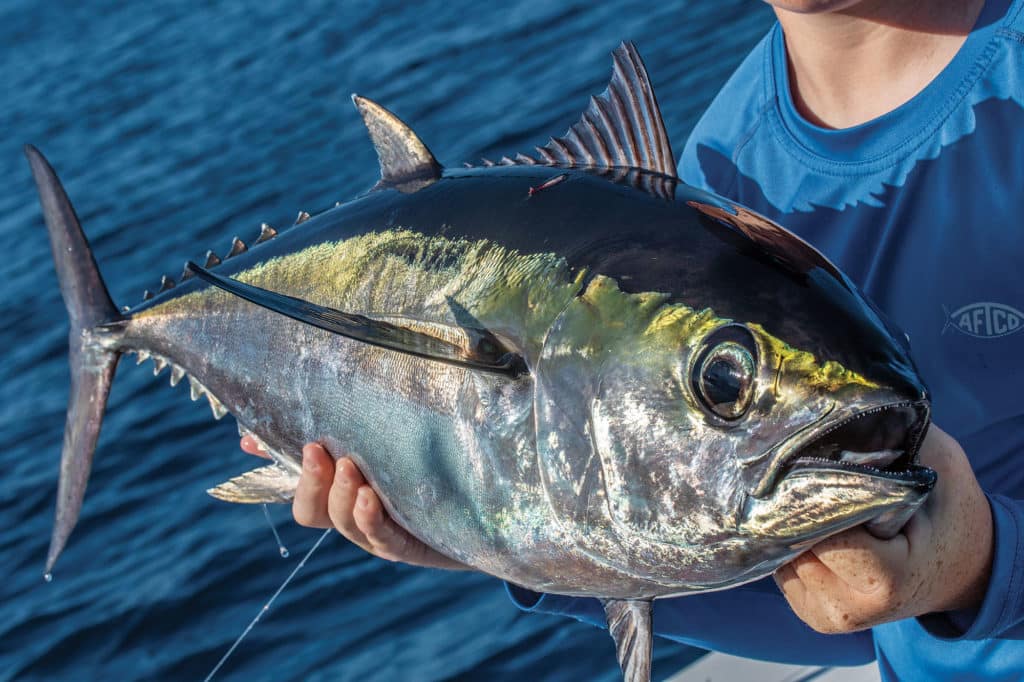
I’ll never forget my first kiss, the first time I got punched in the face or my first blackfin tuna on a jig. During winter 2006, I heard a rumor that Hatteras skipper Scott Warren was catching blackfin tuna on vertical jigs. In those days, few people fished Hatteras in winter, hardly anyone used vertical jigs and big blackfin were an anomaly. A few phone calls later, I was scheduled to fish on Warren’s legendary Big Tahuna.
Windblown and sea-smacked in the cold months, Hatteras is a seasonal ghost town. The tourists have long since left the isolated island off the coast of North Carolina, most of the charter boats are perched on blocks or visiting southern seas, and even the commercial fishing fleet is quiet.
The parking lot at Teach’s Lair Marina was empty that February morning when I pulled in a few hours before dawn. Only one boat was lit up at the dock, diesel engines already rumbling. I struggled to make out the faces of Warren and mate Kenny Koci (who later captained Big Tahuna) wrapped in sweatshirt hoods.
A few minutes later, Big Tahuna‘s anglers for the day piled onto the boat, and we were off through the pre-dawn twilight.
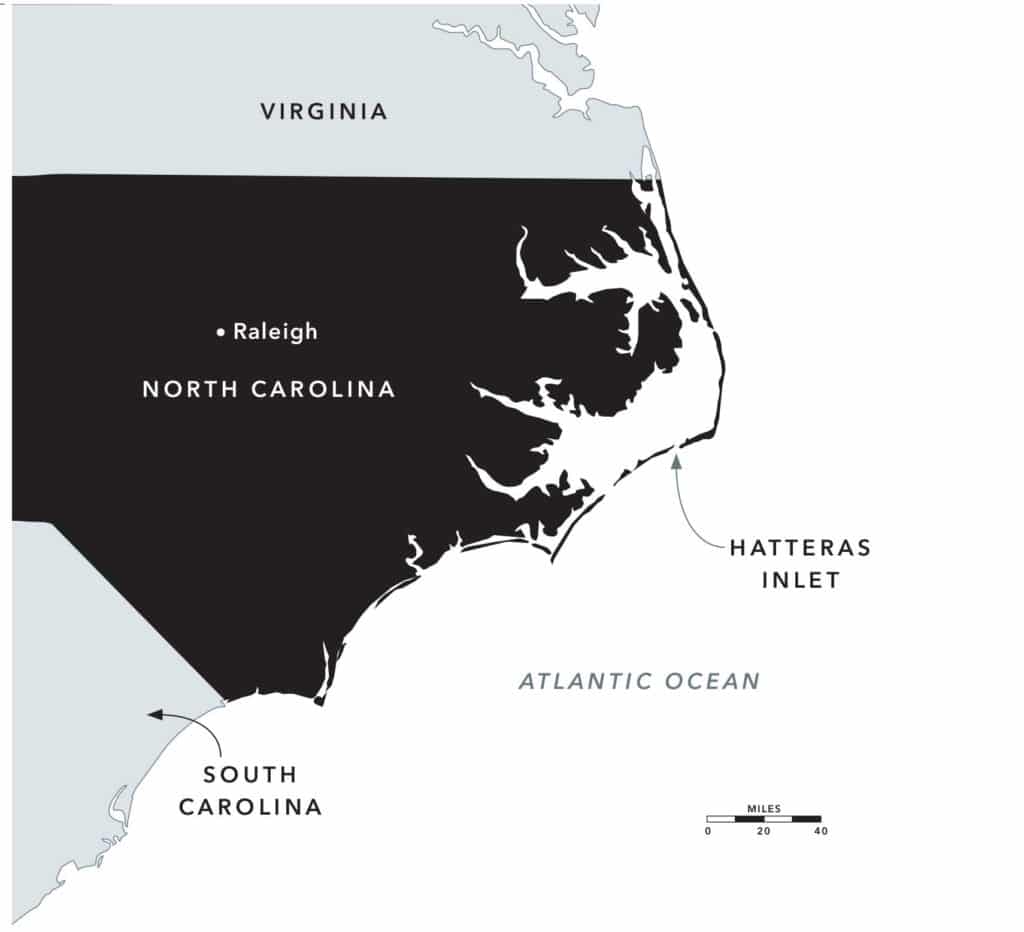
Known as the Graveyard of the Atlantic, Hatteras Inlet is no joke any season of the year. Winter is especially exciting. In addition to howling winds, a strong Gulf Stream current and huge rollers, the days are short and temperatures can be frigid. We started the day layered in fleece and nylon.
The 50-foot sportfisher rolled through the slop without complaint, carrying us to the fishing grounds — a series of seamounts that the locals call “rocks,” 22 miles southeast of Hatteras Inlet. Shortly after we passed over the color change from dirty-green inshore water to the deep-blue Gulf Stream, Warren slowed the boat, and the party emptied out of the comfort of the cabin.
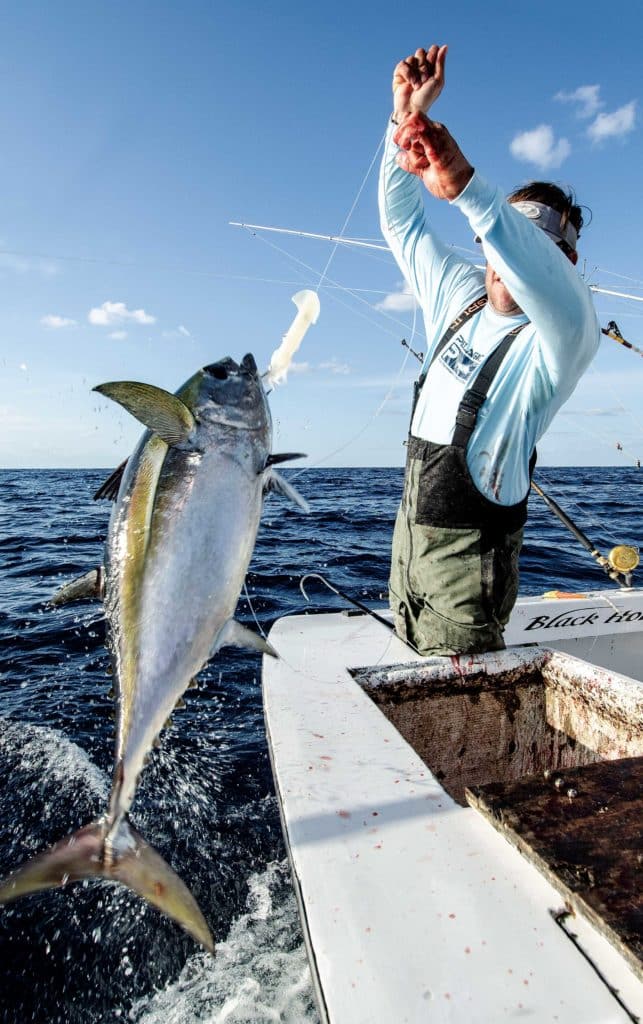
Fishing Vertical Jigs for Blackfins
Big Tahuna motored in circles while the captain watched the fish finder. Six anglers lined the covering boards, 6-foot rods dangling foot-long metal jigs over the side. We waited for the signal to drop the lures as the boat rocked in the choppy seas. A sharp wind drove whitecaps into the side of the boat, dousing those in the cockpit with showers of warm spray on a cold day.
“Try this, six colors!” Warren called from the bridge. Six colors equates the depth at which he marked fish on the sonar to the regular changes in color on our braided lines. I flipped my high-speed conventional reel out of gear and watched the color on the depth-indicator line change six times, knowing that each color measures 30 feet.
I kicked the reel into gear and started jigging. Sticking the rod butt under my left arm, I turned the reel handle as fast as possible while jerking the rod tip. Three jerks into my retrieve, the jig was whacked in a fierce strike.
The slight rod tip bent to the water as line shredded off the spool. I moved the rod butt to my lower gut as the fish made its first run. When the line slowed, I began to retrieve. The fish continued to buck and run while I used every resource to gain line. As I jammed the rod above my groin, my forearm burned, and every run produced grunts and groans as the fish beat my ass.
One by one, the other anglers had hooked fish and now struggled similarly to gain line. In minutes, we were bobbing and weaving through crossed lines and quickstepping to stay standing. Koci raced from angler to angler while Warren called the dance from the bridge.
By the time I spotted the first silver flash of my tuna 10 feet below the boat, the whole bunch were cursing and laughing while slipping and sliding. Koci moved in to gaff my 20-pound blackfin and flip it into a fish box already bloody with spastic tuna.
The protocol was repeated for the next five hours. Make a drop; hook a burly blackfin; fight for your fish; dance, slide, yell and holler. The beefy blackfin were a perfect match for our medium-action jigging gear. The fish box began to fill up amid the fast-and-furious action. Bouncing around the mosh pit had me sweating and peeling off layers.
By the end of the day, the winds calmed and the chop turned to a rolling swell. Warren turned Big Tahuna toward Hatteras, and the crew shuffled into the cabin to lick wounds. I sported purple-and-black bruises; every muscle ached, and my hands were hamburger. I felt great.
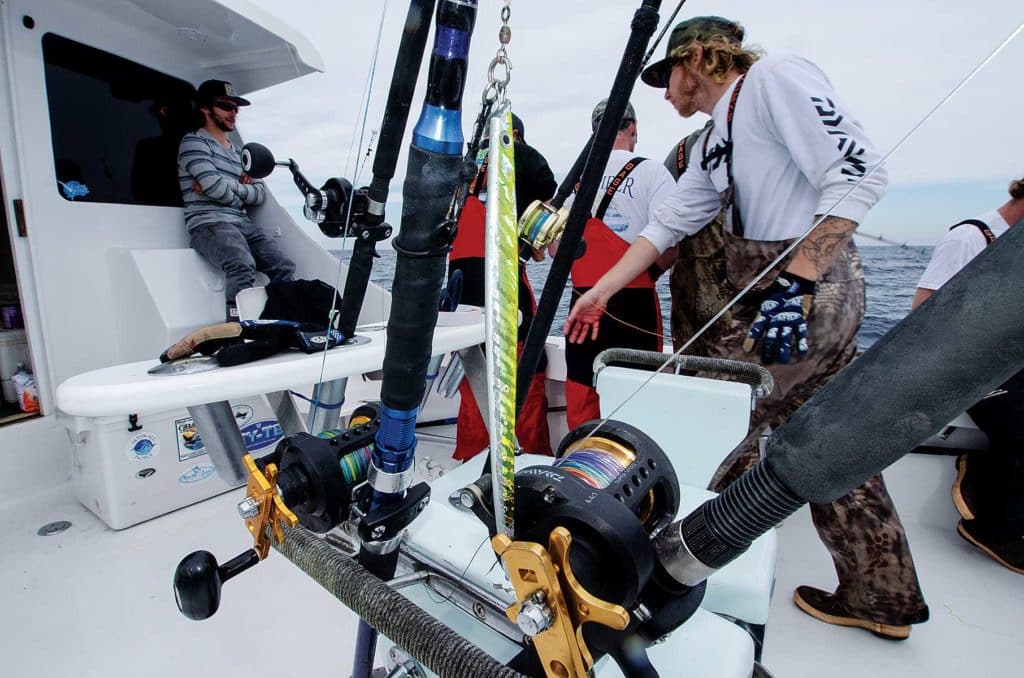
Blackfin Tuna in the Atlantic Ocean
Blackfin tuna are the smallest member of the genus Thunnus (the true tunas: bluefin, yellowfin, bigeye and others); the world record stands at 49 pounds, 6 ounces, taken off Marathon, Florida, in 2006. The North Carolina state-record blackfin, taken in 2011, weighed 40 pounds, 11 ounces.
They might smaller than other tunas, but they’re prolific and tasty. Each winter, blackfin gather in the warm Gulf Stream water as it swirls over the rocky edge of the Continental Shelf, gorging on huge clouds of baitfish caught in the considerable current.
Also during winter, the cold Labrador Current pushes down the Atlantic coast from the north, colliding with warm, clear Gulf Stream water from the south. Where the two currents meet, the water temperature can differ up to 20 degrees.
On the cold side of the break, the water is dark, dirty green; the warm side appears clear blue. The current and waves are calmer on the cold side. In the stream, the current can run to 4 knots, whipping the sea into a frenzy.
Where the Gulf Stream pushes over offshore rocks and ledges, bait and predators line up to play out the food chain. Amberjack, false albacore (little tunny) and huge sharks mix in the melee, in addition to blackfin tuna. Amberjack and albacore put up a good fight, but they aren’t locally favored for eating. Most are released.
To avoid sharks, tuna anglers need to work fish to the boat quickly. That can be tough to do with a blackfin as they pull and run without mercy. Dally on the retrieve, and a man‑eater will eat the tuna.
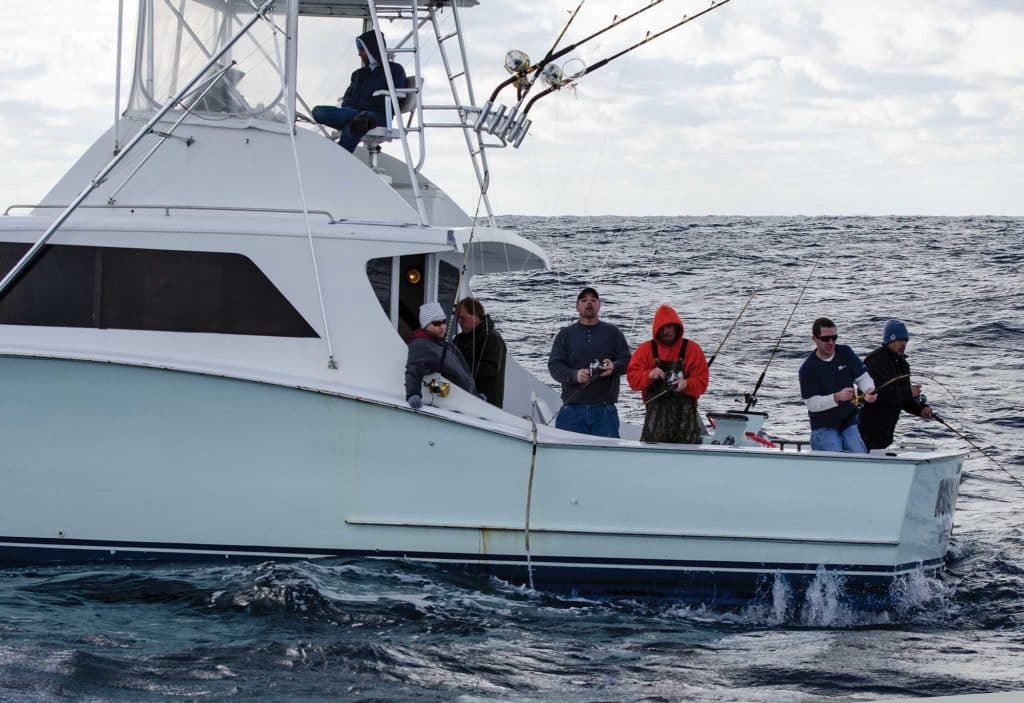
Tuna in Changing Conditions
As Hatteras boats explored the winter blackfin bite, they discovered more than one way to skin that cat. Over the past 20 years, blackfin jigging has waxed and waned. Some years, the bite is hot; other years, it’s cold.
Changing conditions also affect how anglers target tuna. Capt. Andy Piland on Good Times, a custom 47 Carolina sport-fisher, has made a science of catching blackfin tuna. His former partner Capt. Tim Hagerich, who now owns Black Pearl Charters, insists: “You have five ways to catch a blackfin, and you’d better be ready to use each.” On any given day, Hatteras skippers might troll ballyhoo, work a greenstick, fly a kite, drop jigs or throw topwaters.
Fishing over the years, I’ve done it all with these captains. Sometimes we fish three or four tactics in one day. Changing tactics allows the crew to stay on the blackfin bite through winter and into spring. As the season progresses, the tuna seem to get more finicky.
Early in winter, blackfin feed deep in the water column, where a vertical jig matches the menu. The best jig bite starts in January and runs through March, when the water is dingier.
Read Next: Tunas of the World — An Illustrated Guide
In early spring, the water over the rocks clears and the fish turn their attention to chasing flying fish, and local skippers switch to trolling baits. While jigging for blackfin tuna has a certain masochistic appeal, the biggest fish often come to a trolled bait. “We catch blackfin up to 30 pounds trolling, when they won’t bite the jig,” Hagerich says. “The tuna will jump clear out of the water to grab a flying fish 5 feet in the air.” The key to fooling the tuna is getting a bait into the air.
“When it’s rough as hell, we catch blackfin on ballyhoo,” Hagerich says, trolling Sea Witches with medium ballyhoo at 6 knots so the lures leap and splash from wave to wave. When it’s calm, the fish respond to a rubber squid dangling from a greenstick. By late May, the water is clear and warm, and the blackfin become pickier. “The kite works best in the clearest water,” Hagerich explains.
Suspending two rubber flying fish from the kite line is the sneakiest way to fool blackfin. Hagerich cites many days when he spent hours jigging, trolling ballyhoo, and even fishing the greenstick until the crew put up the kite, and trophy blackfin suddenly exploded out of the water.
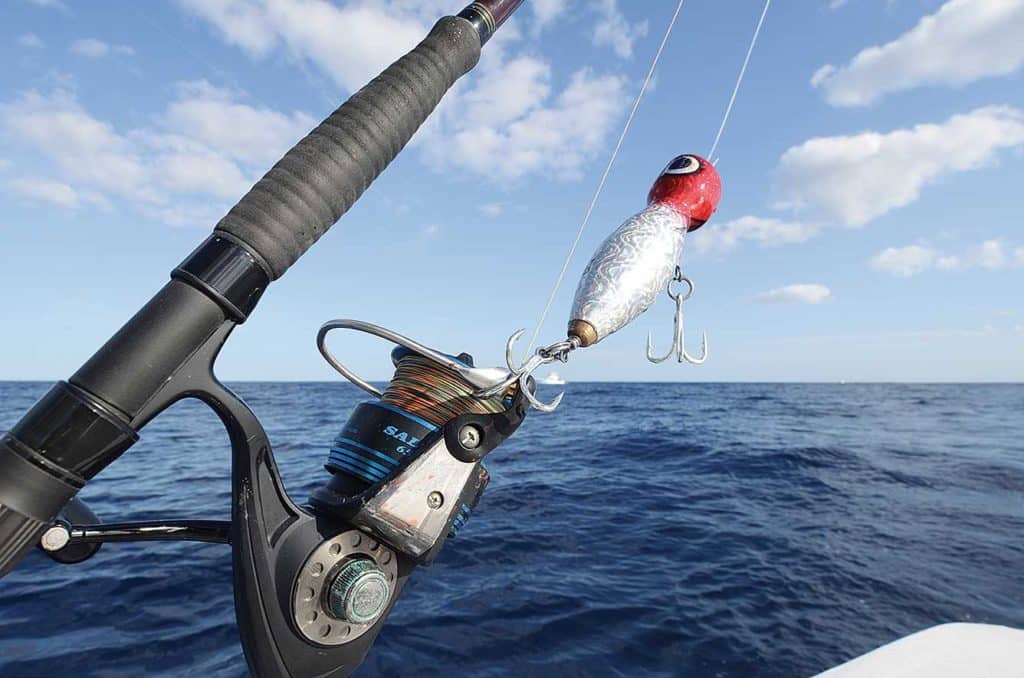
Battling a Monster Blackfin Tuna
Excited by the prospect of a near-world-record-size blackfin, I enthusiastically jumped aboard Good Times. Riding in the bridge, my teeth clenched tight and hands gripped the hardtop as Piland navigated the boat through the shallow shoals and crashing breakers of Hatteras Inlet.
Like professional guides, weekend warriors can’t pick their days, so I found myself rolling and pitching an hour and a half to the fishing grounds. Choppy, windswept rollers are tough on fishermen, but tuna treat rough water like an amusement park as they leap out of the water, chasing flying fish through the air.
Seconds after Piland slowed the boat, Hagerich deployed a dozen rods pulling Sea Witches with ballyhoo. In minutes, chunky blackfin began exploding on the baits. Piland continued to troll as line after line went down. Before he pulled back the throttles, most of the rods were bent over and bucking.
While the anglers cranked in big blackfin, Hagerich worked to keep the lines straight, gaffing fish and rigging baits. When I spotted tuna skying out of the water 10 yards off the stern, Hagerich grabbed a hefty spinning rod and shoved it into my hands. “Cast!” he ordered.
I launched the popper off the stern, somehow managing to clear the lines, outriggers, teasers and halyards. The 8-inch popper splashed down in the middle of the tuna air show. I pulled the rod and cranked the handle. The plug chugged, throwing a cup of water. I cranked; the lure popped again. On the third turn of the handle, a burly tuna flew out of the water to descend on the plug.
Excited, I hauled back on the rod — and yanked the plug out of the tuna’s mouth. “You got to let him take it,” Piland said, laughing from the bow. Feeling the pressure of 16 eyes watching my moves, I chugged the plug again, and the fish attacked.
This time, I slowed and dropped the rod tip to the fish. The line came tight, but I gave the fish a breathless pause before lifting the rod and putting on the pressure. The blackfin responded with another blistering run, jabbing the rod butt into my armpit and forcing me to cross the deck until my thighs slammed into the covering board.
The rest of the crew cleared the trolling lines, leaving me to battle a big blackfin tuna. As Hagerich shouted orders, Piland worked to keep the boat straight and my line in the clear. I put on the pressure, wedging the rod butt into my groin and stretching my forearms for maximum power to winch the stubborn fish from the depths. I got my first good look at the beefy tuna at the same time the fish had its first good look at me. My muscles had redlined, but the tuna found more fight in the tank; it turned and rushed for the darkness, line again disappearing from the reel.
Eventually, with the silver-and-black missile boatside, Hagerich reached out with the gaff, and swung a 25-pound blackfin tuna over the gunwale and into the fish box. My arms were like Jell-O and pudding filled my legs as the tuna continued to kick its tail like a jackhammer until the lid was closed. Piland quickly pushed the throttles forward, and Hagerich deployed the rigs.
No rest for the weary, but there’s no better way to stay warm in winter off Hatteras than pulling on blackfin tuna.
About the Author
Ric Burnley is an angler, editor, author and teacher who lives in Virginia Beach, Virginia. When he isn’t fishing or writing, he’s in the classroom teaching at-risk teenagers that the pen is mightier than the sword.

